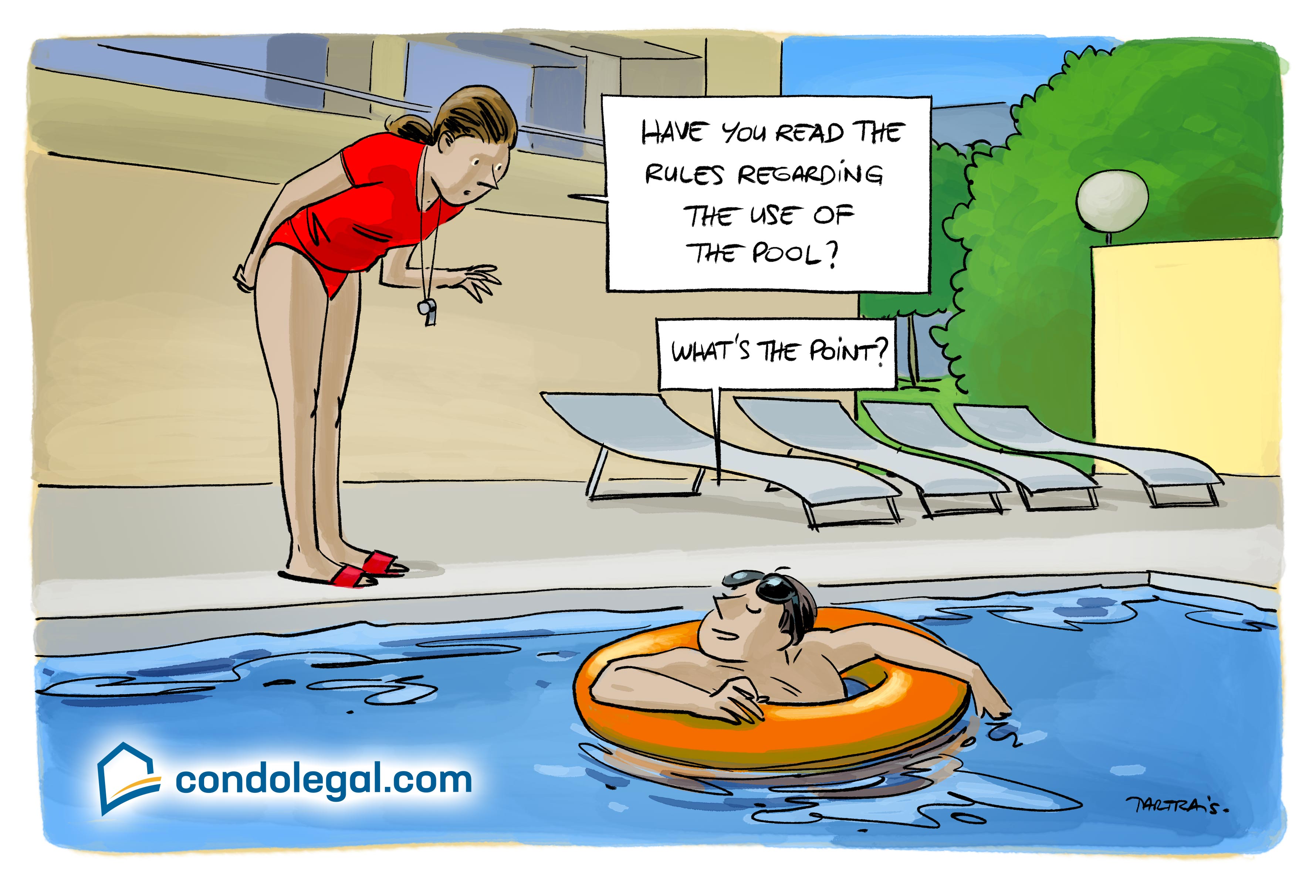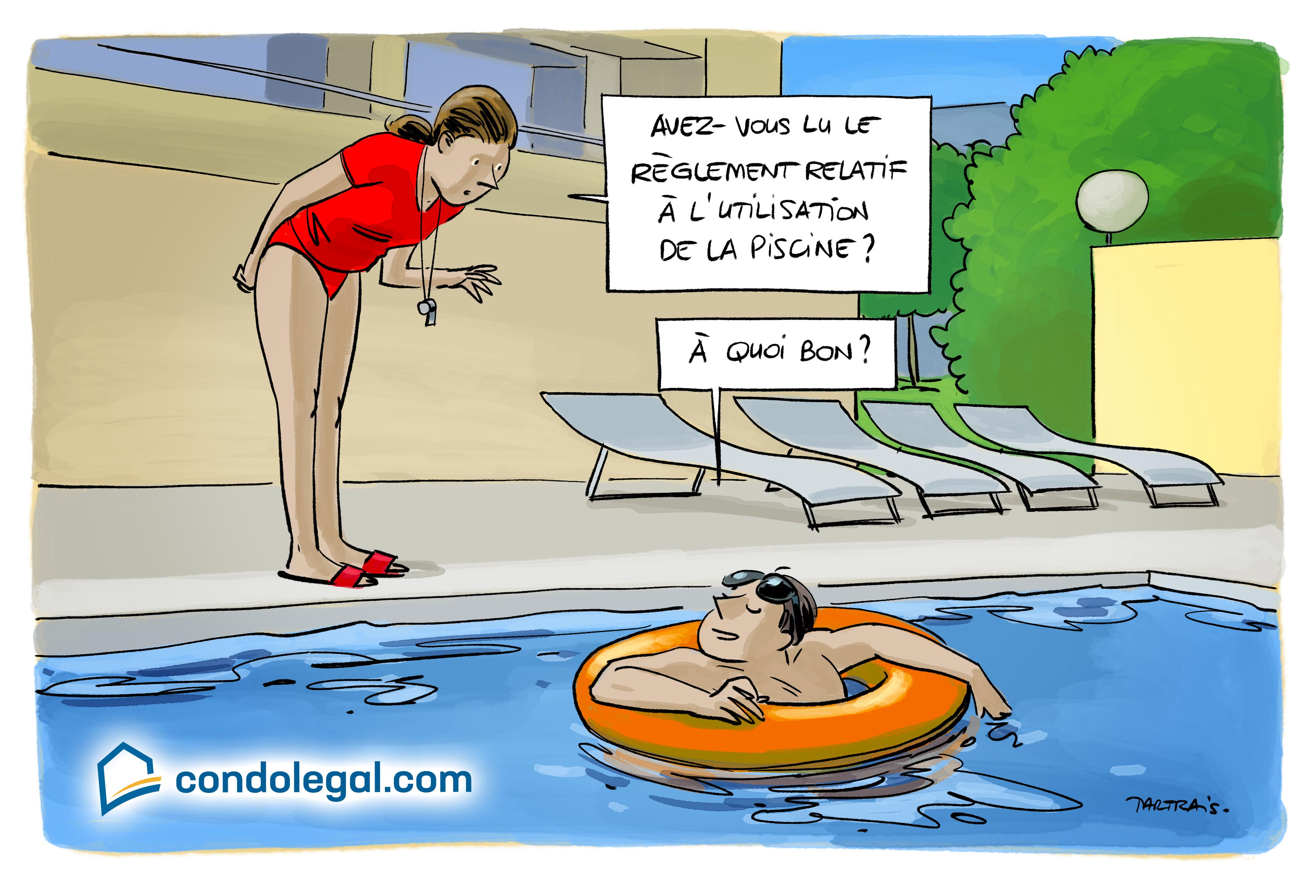Date published: 04/05/2024
Swimming pool in a divided co-ownership
 The presence of a swimming pool in a divided co-ownership is a significant attraction for the building's occupants, transforming common portions into a haven of relaxation and comfort. This facility allows residents to enjoy swimming pleasures without leaving the comfort of their home. Effective management and proper use of this common space are crucial for optimizing the well-being of the co-owners and occupants of the building. Additionally, it is important to be familiar with the applicable rules for the use of the co-ownership pool to ensure that its use remains safe and enjoyable for everyone.
The presence of a swimming pool in a divided co-ownership is a significant attraction for the building's occupants, transforming common portions into a haven of relaxation and comfort. This facility allows residents to enjoy swimming pleasures without leaving the comfort of their home. Effective management and proper use of this common space are crucial for optimizing the well-being of the co-owners and occupants of the building. Additionally, it is important to be familiar with the applicable rules for the use of the co-ownership pool to ensure that its use remains safe and enjoyable for everyone.
Importance of a swimming pool in co-ownership
A swimming pool, generally located in the common portions, adds undeniable value to the property. Not only is it a center for relaxation and socialization, but it also increases the attractiveness of the building to potential buyers and tenants. It is essential that the syndicate of co-owners takes charge of its maintenance and preservation to ensure safe and enjoyable use.
Usage rights and rentals
When a co-owner opts to rent out their home, they transfer the exclusive use of the unit as well as access to common facilities such as the pool to their tenant. This transfer of rights implies that during the rental period, the co-owner loses the right to use this common part of the co-ownership, thus ceding all access privileges to the tenant. Although the co-owner retains all rights associated with their co-owner status (e.g., the right to vote and consult on co-ownership matters), they no longer benefit from the daily use of common areas, including the pool, until the unit is returned to them.
It is also important to note that the co-ownership declaration cannot impose restrictions that would prohibit tenants from accessing the pool, as no clause can limit this right unless justified by the destination of immovable.
Safety rules
It is essential that the declaration of co-ownership (by-laws of the immovable) integrates strict safety rules for the pool to maintain a safe environment for all occupants. These rules should include restricting access to the pool outside opening hours and prohibiting risky behaviors such as pushing or using glass containers near the water.
Access should be limited for unsupervised children and people under the influence of alcohol.To ensure compliance with these rules, a penal clause should be introduced in the declaration of co-ownership (constituting act of the co-ownership), sanctioning any violation to enhance safety and proper use of the facilities. These measures ensure that the pool remains a secure and enjoyable relaxation space for all co-ownership occupants.
Surveillance and safety
The Regulation respecting safety in public baths specify in Article 19 that a pool with a water surface area exceeding 150 m2 must be equipped with surveillance stations. Article 26 further specifies that the owner must ensure that the minimum number of lifeguards and lifeguard assistants complies with Annex 3. However, Annex 3 of this regulation states that a pool larger than 150 m2 must have at least one lifeguard on duty at all times when the pool is open.
However, do syndicates of co-owners, under these specific conditions, need to hire lifeguards? According to the Régie du bâtiment du Québec (as of May 27, 2020), the answer is "no" because "Pools in divided co-ownership residential buildings are not covered by the current scope of the Regulation respecting safety in public baths Chapter B-1.1, r.11). These divided co-ownership buildings are not considered public buildings. Consequently, the pools attached to them are excluded from the scope defined in article 2 of this regulation, and the surveillance requirements prescribed by Article 26 do not apply."
Therefore, there is no obligation to have a lifeguard present. However, it remains essential to ensure the safety of swimmers by other means, including mandatory safety devices such as barriers, sound alarms, equipment for the area with electrically insulated poles, and life buoys. Moreover, it is imperative to plan for immediate evacuation in case of water disturbance or the presence of dangerous substances.
Mandatory presence of lifeguards
It is important to highlight that exceptions exist to the general rule that exempts a co-ownership from the obligation to have lifeguards. Specifically, a pool may be considered a public bath when it is accessible to the public. This situation is particularly found in commercial residential complexes that offer paid access to sports facilities, including gyms, pools, and spas. In such a situation, the syndicate of co-owners must imperatively hire qualified lifeguards to ensure the supervision of the pool.
Hygiene and safety standards
Pools in co-ownership must meet strict hygiene and safety standards due to the high number of bathers. It is essential to choose an effective filtration system and maintain an appropriate pH to prevent the proliferation of bacteria and ensure a healthy environment for all users.
Distribution of charges for the maintenance and replacement of the pool: principle
The maintenance and management costs related to the pool are considered common expenses. According to article 1064 of the Civil code of Quebec, these expenses should be distributed among all co-owners proportionally to the relative value of their fraction. However, in a mixed-use co-ownership where the pool is defined as a common portions for restricted use, reserved exclusively for residential unit co-owners, for example, the distribution of charges must be adjusted accordingly. In this case, only the co-owners who have access to this facility are responsible for the associated costs, which notably include minor repairs and regular maintenance. These specific fees are known as particular common expenses, reflecting their targeted nature and their application limited to the beneficiaries of the restricted use.
Furthermore, under article 1072 paragraph 3 of the Civil code of Quebec, the contribution of co-owners to the contingency fund can be adjusted based on their specific rights over restricted common portions. Consequently, the declaration of co-ownership could include a clause stating that co-owners who have exclusive use of the pool are responsible for the costs associated with its replacement, as a specific common charge.
Distribution of charges for the maintenance and replacement of the pool: special cases
It is important to qualify the general rule regarding the distribution of charges for the maintenance of pools, as there are special cases. For example, in a horizontal co-ownership, a pool may be located on land that is an integral part of a co-owner’s private portion. Sometimes, it may be situated in a private area of a vertical co-ownership, as is the case in some condo-hotels or residences for the elderly. In these instances, the concerned co-owner is solely responsible for all associated costs, including maintenance and replacement.
 WHAT YOU SHOULD KNOW! The pools of residential buildings in divided co-ownership are not subject to the current scope of the Regulation respecting safety in public baths. Therefore, the surveillance requirements and certain public safety standards are not mandatory, although compliance with hygiene standards remains crucial for the safety of users.
WHAT YOU SHOULD KNOW! The pools of residential buildings in divided co-ownership are not subject to the current scope of the Regulation respecting safety in public baths. Therefore, the surveillance requirements and certain public safety standards are not mandatory, although compliance with hygiene standards remains crucial for the safety of users.
 WHAT TO KEEP IN MIND: A pool in divided co-ownership enhances the well-being of the occupants and generally increases the value of the property, but requires careful management and compliance with strict hygiene and safety standards to ensure pleasant and safe use for all.
WHAT TO KEEP IN MIND: A pool in divided co-ownership enhances the well-being of the occupants and generally increases the value of the property, but requires careful management and compliance with strict hygiene and safety standards to ensure pleasant and safe use for all.
 WARNING! To ensure safety at the co-ownership pool, it is essential to adopt strict rules, such as limiting access outside opening hours and prohibiting risky behaviors. A penal clause in the co-ownership declaration will reinforce compliance with these measures.
WARNING! To ensure safety at the co-ownership pool, it is essential to adopt strict rules, such as limiting access outside opening hours and prohibiting risky behaviors. A penal clause in the co-ownership declaration will reinforce compliance with these measures.
Back to the factsheets





